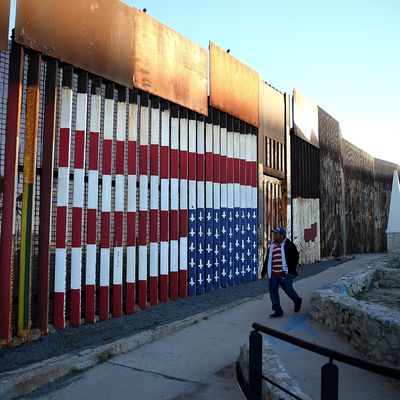
It seems the common Donald Trump campaign chant, “Who’s gonna pay for the wall?” “Mexico!” might be even more misleading than previously thought.
In recent weeks President Trump has been threatening to shut down the government if Congress doesn’t give him more U.S. taxpayer money to build his border wall. In the meantime, his administration plans to take $20 million that Congress allocated for foreign assistance, and use it to pay Mexico for plane and bus fare to deport as many as 17,000 people in the country illegally.
The administration said it plans to divert the money in a notice recently sent to Congress, according to the New York Times. The idea is to have Mexico deal with the influx of Central American migrants before they reach the border and get involved in U.S. immigration proceedings, which Trump considers far too cumbersome.
“We are working closely with our Mexican counterparts to confront rising border apprehension numbers — specifically, a 38 percent increase in families this month alone — directly and to ensure that those with legitimate claims have access to appropriate protections,” said Katie Waldman, a spokeswoman for the Department of Homeland Security.
The Times reports this is part of a larger effort to thwart Congress’s decisions on how money should be spent abroad:
The plan, which has been debated internally for months, is part of a broader push by the Trump administration to redirect billions in foreign assistance to other priorities. The administration has yet to spend nearly $3 billion in foreign aid, money allocated last year by Congress with broad bipartisan support. Hundreds of millions of dollars meant to help stabilize Syria and support Palestinian schools and hospitals has already been redirected.
Many Americans were surprised to learn during the transition period that Trump’s plan to “build the wall” entailed U.S. taxpayers fronting the money, then Mexico reimbursing us. (Trump actually mentioned this at one point on the campaign trail, but some missed the nuance behind his catchphrase.)
Eighteen months later, Trump’s “big, beautiful wall” is merely 14 miles of a wall in San Diego and 20 miles in Santa Teresa, New Mexico (these projects involve replacing old barriers with what Customs and Border Protection used to call “fencing,” and are not based on the flawed wall prototypes). With no massive structure to brag about, Trump has taken to boasting about the amount of U.S. money that’s gone into the project — and he’s even inflated the number. During rallies in June and July, Trump touted the $1.6 billion Congress allocated in the spring, but the Washington Post reported that the figure recently shot up.
“We’ve started the wall,” Trump said at a rally in Montana earlier this month. “We’ve spent $3.2 billion on the wall. We’ve got to get the rest of the funding.” He later repeated the figure, adding, “We’ve done a lot of work on the wall. A lot of people don’t understand that.”
Trump may be adding in the several billion he hopes to secure from Congress in negotiations this fall.
With no physical wall to solve all the nation’s immigration troubles, the Trump administration turned to a “zero tolerance” policy that led to the separation of about 2,600 children from their parents before the national uproar prompted the president to discontinue the practice in June. While Attorney General Jeff Sessions and White House Chief of Staff John Kelly both said the policy was meant to deter migrant families from entering the U.S., statistics released Wednesday by DHS show that wasn’t the effect. In August arrests of migrant families crossing the border rose 38 percent from the month before. About 12,800 family members crossed into the U.S. in August, up from 9,247 in July.
Jennifer Podkul, the policy director for the legal nonprofit Kids in Need of Defense, told Dallas News, “This jump is consistent with deteriorating conditions in Central America as well as annual migratory patterns. It also shows deterrence methods like family separation do not work in a real refugee crisis.”
But Kevin McAleenan, the head of U.S. Customs and Border Protection, had a different explanation. He said there is still a “gap in the legal framework” of the U.S. immigration system, and “frankly the highlighting of that loophole that’s occurred all summer” has produced “a very stark trend.”
“Now for families and kids there are no consequences for being apprehended,” McAleenan said. “In fact, they are seeking to be apprehended [in order] to start their process to being allowed into the United States to await a court proceeding that’s going to take years.”
Traumatizing children just to send a message didn’t work this time, but that doesn’t prove the plan was ineffective. The take away is that the public needs to have more faith in Trump’s immigration policies, whether that means shrugging off separated families’ suffering, letting the administration reallocate foreign aid as it pleases, or shelling out billions for a wall, even as Mexico insists they’ll never pay us back.






























